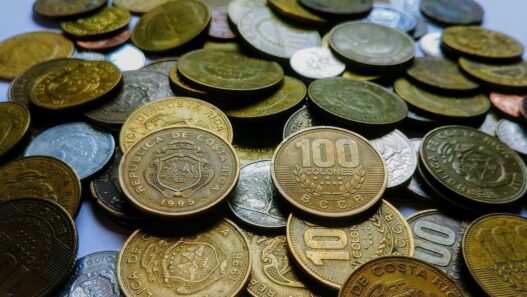Every traveller has that drawer – you know the one. Tucked away in a corner of your room, it's overflowing with trinkets from past adventures: a leaning Tower of Pisa keychain, a faded boarding pass from Tokyo, that adorable (but cracked) ceramic shot glass from Prague. Maybe there's a packet of Ceylon tea from Sri Lanka you swore you'd brew someday, or a handwoven bookmark from a monastery in Bhutan that you forgot was even there.
The truth is, many traditional souvenirs lack a real connection to the places we visit. They're mass-produced, forgettable, and in the end, don't do justice to the unforgettable experiences they were meant to commemorate.
So, should you stop buying souvenirs altogether? Not at all. But there's a better, more meaningful alternative – one that's likely already in your pocket or wallet at the end of every trip.
Enter: local currency.
Whether it's a brightly coloured Indonesian rupiah, a centuries-old euro coin, or the beautifully designed Costa Rican colón, currency is culture in your palm. It reflects national pride, historical moments, important figures, and even a country's values. It's far more than just spending power – it's portable art, and one of the most underrated keepsakes you can collect.
As someone who's spent years backpacking, working remotely, and dog-sitting across continents, I've made it a habit to keep at least one small note or coin from every country I visit.
Not only is it lightweight and practical (unlike that bulky snow globe from Switzerland), but every time I look at those currencies back home, they trigger vivid travel memories – like the day I almost missed the last ferry in Santorini, or when I bartered with a vendor in Marrakech's souks.
Stay tuned – I'll also be sharing how to store, display, and even gift your currency finds in creative ways. Because souvenirs should tell a story, not gather dust.
READ ALSO: Cheapest Way To Travel Around Europe 13 Ways To Make Money Through Blogging 7 Ways To Make Money While Travelling In An RV
Currency as a Window Into Culture and Identity
Money isn't just about buying things – it's a miniature reflection of the soul of a nation. Whether it's the portrait of a beloved leader, an endangered animal, or a piece of national architecture, currency tells the world what a country values.
For curious travellers and collectors alike, banknotes and coins offer an authentic, pocket-sized entry into a country's culture, history, and national pride.
1. Design That Speaks Volumes
Every detail on a currency note – from colours to faces to fonts – is chosen with purpose. Unlike souvenirs sold at tourist markets, currency is designed by national institutions and often tells deeper stories that many travellers miss.
Take Mexico's 500 peso note: On one side, it features Benito Juárez, a former president and indigenous rights advocate, symbolising reform and resilience. Flip it over, and you're greeted by whales breaching off the Baja California coast, reflecting the country's rich biodiversity and natural heritage. It's a perfect blend of political legacy and ecological pride 2 2 elements that define Mexico today.
Or consider the euro. While it circulates across more than 20 countries, its notes are a study in unity through diversity. Each denomination features a different architectural style – Romanesque, Gothic, Baroque, and beyond – not from any specific country, but as imagined representations. This approach makes the euro more than a shared currency; it's a design symbol of cooperation and shared European identity.
2. Material Choices That Reflect Values
Currency isn't only about what's on the surface. The material itself reveals a country's priorities, especially when it comes to durability, sustainability, and technology.
Canada's Polymer Bills
Known for being virtually indestructible, waterproof, and colour-rich. They're not just beautiful, they're also practical, aligning with Canada's reputation for innovation and efficiency.
Japan's Yen Notes
Tend to focus on scholars, poets, and educators, not just politicians or military figures. Featured personalities like Fukuzawa Yukichi, an author and educational reformer, highlight Japan's cultural emphasis on learning and knowledge. Even the design elements include scenes from classical Japanese literature or art.
New Zealand And Australia
Both known for their vibrant ecosystems and indigenous heritage, incorporate native wildlife and bilingual elements that honour both colonial and Māori or Aboriginal languages.
3. Commemorative Notes: Currency That Marks History
Currency also marks important events and national milestones. According to the International Bank Note Society, more than 200 new designs are introduced annually, many of them commemorative editions that celebrate anniversaries, Olympic games, or historic changes in leadership.
- Ukraine released a 20-hryvnia note in 2021 to commemorate 30 years of independence.
- Singapore issued a series of gold-foil banknotes to celebrate its 50th year of independence, complete with portraits of key founding figures.
- South Africa updated its rand banknotes to honour Nelson Mandela's legacy with vibrant designs showing key moments from his life.
For the traveller, these notes are more than money — they're conversation starters, keepsakes, and tiny slices of history that you likely won't find in gift shops.
4. Why You Should Pay Attention to the Money in Your Pocket
While it's easy to see currency as disposable or functional, stopping to really look at a note or coin can tell you a lot about a place. It can give clues about:
- Who is celebrated (scientists, poets, warriors, monarchs?)
- What landscapes are considered iconic
- How a nation presents itself to both locals and the world
And when you travel frequently, collecting currency – even if it's just a single small denomination from each place – becomes a powerful, portable way to remember not just where you went, but what that place stood for.
Rare Coin Finds and Collector's Joy
As your collection grows, you'll start to experience collector's joy. This thrilling sensation makes you giddy every time you come across an uncommon piece of currency. You can find rare or discontinued notes and coins tucked away in dusty flea markets, remote border towns, or even pawn shops.
Say you're traveling through Japan's beautiful countryside and want to take back a memento of this once-in-a-lifetime experience. In this case, you must take at least one ¥5 coin (“Go-en”).
It's very easy to find while shopping, but its design makes it special (it has a hole in the center and features rice, water, and gear imagery, symbolizing agriculture, fisheries, and industry). Plus, in Japanese, “go-en” is a homophone for “good fortune,” so it's a great charm for good luck.
If you're looking for something more valuable, you should keep an eye out for silver bullion coins. These are made from .999 fine silver and are often adorned with intricate designs that showcase national icons. Some of the most popular silver coins ever made belong to Canada, Australia, and Austria, featuring symbols like the maple leaf, the kookaburra, or Vienna's grand concert hall.
You can use some of them at face value, but coin collectors go crazy over such a tiny treasure. Plus, they make brilliant travel keepsakes. They're small, meaningful, and appreciate over time, since silver prices are on the rise.
Bills That Tell a Story
Some souvenirs end up forgotten in drawers. But others – like the wrinkled banknotes you collect along the way – carry memories you can actually feel. They smell like street food, fit in your back pocket, and remind you of the places you've wandered through, sometimes more vividly than photos ever could.
I've kept a stash of them since my first solo trip, and over time, each note has become a marker of not just where I've been, but what I learned – about the world, and about myself.
Here are a few paper bills that stayed with me long after I left the airport.
Vietnam
When I arrived in Vietnam, I was expecting lanterns and rice terraces. What I didn't expect was a bright yellow banknote with an oil rig on it. The 10,000 dong note isn't conventionally pretty, but it reflects the country's rapid transformation.
It was a reminder that Vietnam is more than its temples and pho; it's also a rising industrial power with one foot in tradition and the other racing forward.
That tiny bill stayed tucked in my wallet the whole trip, even through a rain-soaked motorbike ride through Da Lat and early morning noodle hunts in Hanoi. Now, it lives in my travel journal, oil rig and all.
Zimbabwe
This one needs no introduction. I picked up the $100 trillion Zimbabwean dollar from a market stall in Victoria Falls – a vendor handed it over with a wink and a “souvenir special.” It was surreal holding that many zeros in my hand, knowing the actual value was less than a cup of coffee.
It wasn't just a gag; it sparked a real conversation with a local guide about hyperinflation, struggle, and resilience. That note taught me more about Zimbabwe's economic history than any museum could.
Iceland
I remember standing in a gas station near Vik, grabbing coffee and flipping through change when I first noticed the Icelandic bishop staring back at me. Jón Arason, who defied the Reformation and died for it, is the face of the 1,000 krónur note – a national hero few visitors ever learn about unless they look closely at their change.
Iceland's notes don't shy away from the heavy stuff – they tell stories of faith, resistance, and pride. That small bill made me curious enough to visit the National Museum in Reykjavík, where I spent a rainy afternoon deep-diving into Icelandic history I never planned to learn.
You don't always remember where you bought that fridge magnet – but you'll never forget holding a banknote in Zimbabwe, or finding a bishop on your change in a gas station in Iceland. These small slips of paper carry big stories. They reflect the culture, identity, and history of a country – and often spark unexpected conversations while you're still on the road.
If you're building your own travel collection, start small: keep a bill from every country you visit. Jot down where you got it, what you were doing that day, or even who you were with. Over time, you'll create a journal of stories told through currency – a different kind of travel diary.


















![How To Get From San José To Puerto Viejo, Costa Rica [2025 GUIDE]](https://rjema.com/wp-content/uploads/2025/08/How-To-Get-From-San-Jose-To-Puerto-Viejo-Costa-527x700.jpg)
